Class 11: Maths Chapter 4 solutions. Complete Class 11 Maths Chapter 4 Notes.
Contents
- 1 Maharashtra Board Solutions Class 11-Arts & Science Maths (Part 2): Chapter 4- Methods of Induction and Binomial Theorem
- 2 Download PDF
- 3 Chapterwise Maharashtra Board Solutions Class 11 Arts & Science Maths (Part 2) :
- 4 FAQs
- 5 About Maharashtra State Board (MSBSHSE)
- 6 Read More
- 7 IndCareer Board Book Solutions App
Maharashtra Board Solutions Class 11-Arts & Science Maths (Part 2): Chapter 4- Methods of Induction and Binomial Theorem
Maharashtra Board 11th Maths Chapter 4, Class 11 Maths Chapter 4 solutions
Ex 4.1
Prove by the method of induction, for all n ∈ N.
Question 1.
2 + 4 + 6 + …… + 2n = n(n + 1)
Solution:
Let P(n) = 2 + 4 + 6 + …… + 2n = n(n + 1), for all n ∈ N.
Step I:
Put n = 1
L.H.S. = 2
R.H.S. = 1(1 + 1) = 2
∴ L.H.S. = R.H.S.
∴ P(n) is true for n = 1.
Step II:
Let us assume that P(n) is true for n = k.
∴ 2 + 4 + 6 + ….. + 2k = k(k + 1) ……(i)
Step III:
We have to prove that P(n) is true for n = k + 1,
i.e., to prove that
2 + 4 + 6 + …… + 2(k + 1) = (k + 1) (k + 2)
L.H.S. = 2 + 4 + 6 + …+ 2(k + 1)
= 2 + 4 + 6+ ….. + 2k + 2(k + 1)
= k(k + 1) + 2(k + 1) …..[From (i)]
= (k + 1).(k + 2)
= R.H.S.
∴ P(n) is true for n = k + 1.
Step IV:
From all the steps above, by the principle of mathematical induction, P(n) is true for all n ∈ N.
∴ 2 + 4 + 6 + …… + 2n = n(n + 1) for all n ∈ N.
Question 2.
3 + 7 + 11 + ……… to n terms = n(2n + 1)
Solution:
Let P(n) = 3 + 7 + 11 + ……… to n terms = n(2n +1), for all n ∈ N.
But 3, 7, 11, …. are in A.P.
∴ a = 3 and d = 4
Let tn be the nth term.
∴ tn = a + (n – 1)d = 3 + (n – 1)4 = 4n – 1
∴ P(n) = 3 + 7 + 11 + ……. + (4n – 1) = n(2n + 1)
Step I:
Put n = 1
L.H.S. = 3
R.H.S. = 1[2(1)+ 1] = 3
∴ L.H.S. = R.H.S.
∴ P(n) is true for n = 1.
Step II:
Let us assume that P(n) is true for n = k.
∴ 3 + 7 + 11 + ….. + (4k – 1) = k(2k + 1) …..(i)
Sept III:
We have to prove that P(n) is true for n = k + 1,
i.e., to prove that
3 + 7 + 11 + …+ [4(k + 1) – 1] = (k + 1)(2k + 3)
L.H.S. = 3 + 7 + 11 + …… + [4(k + 1) – 1]
= 3 + 7 + 11 + ….. + (4k – 1) + [4(k+ 1) – 1]
= k(2k + 1) + (4k + 4 – 1) …..[From (i)]
= 2k2 + k + 4k + 3
= 2k2 + 2k + 3k + 3
= 2k(k + 1) + 3(k + 1)
= (k + 1) (2k + 3)
= R.H.S.
∴ P(n) is true for n = k + 1.
Step IV:
From all the steps above, by the principle of mathematical induction, P(n) is true for all n ∈ N.
∴ 3 + 7 + 11 + ….. to n terms = n(2n + 1) for all n ∈ N.
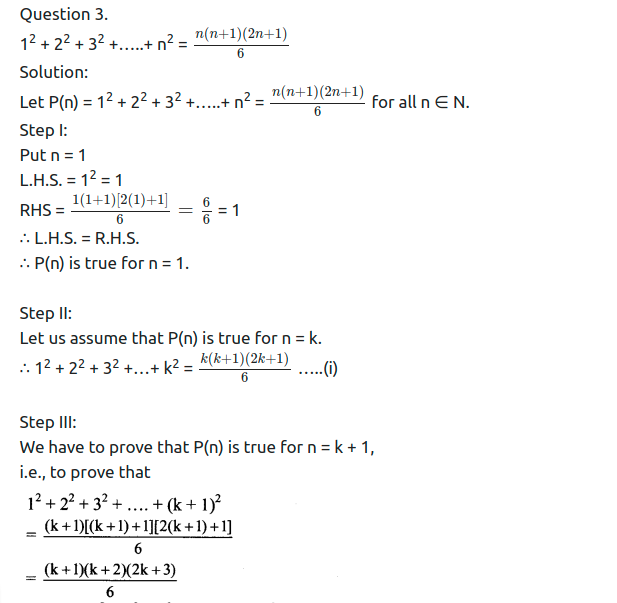

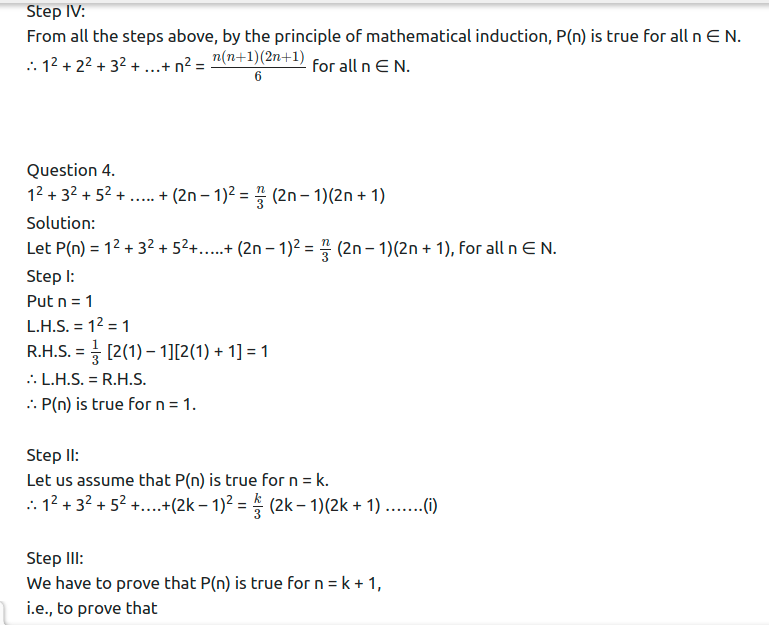
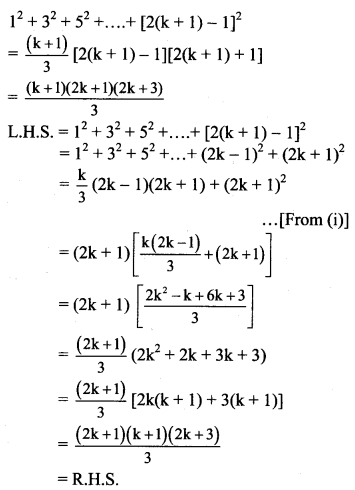
∴ P(n) is true for n = k + 1.
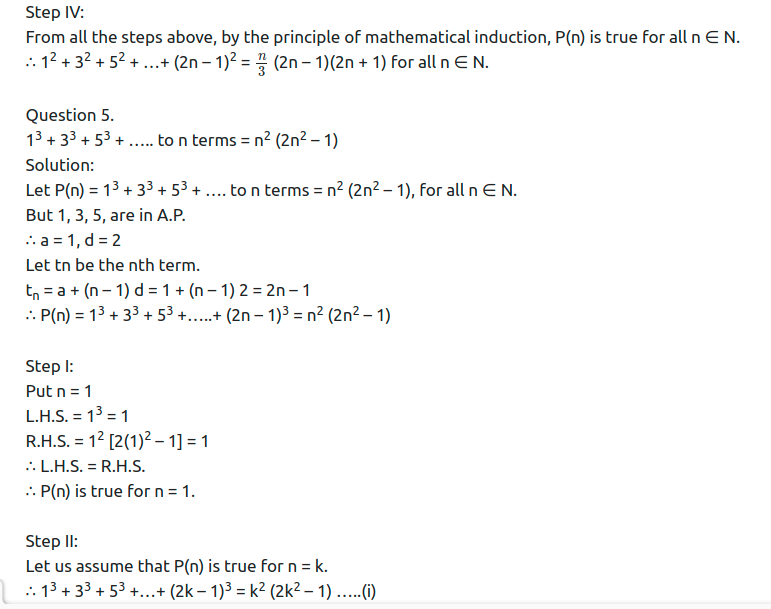
Step III:
We have to prove that P(n) is true for n = k + 1,
i.e., to prove that

∴ P(n) is true for n = k + 1.
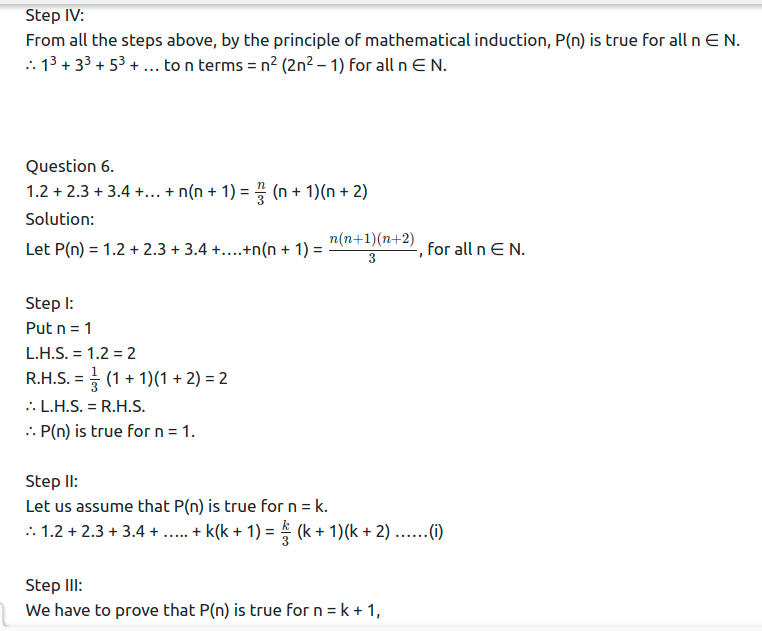
i.e., to prove that
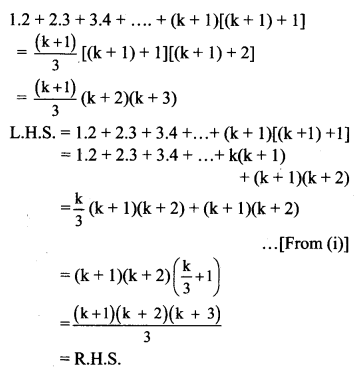
∴ P(n) is true for n = k + 1.
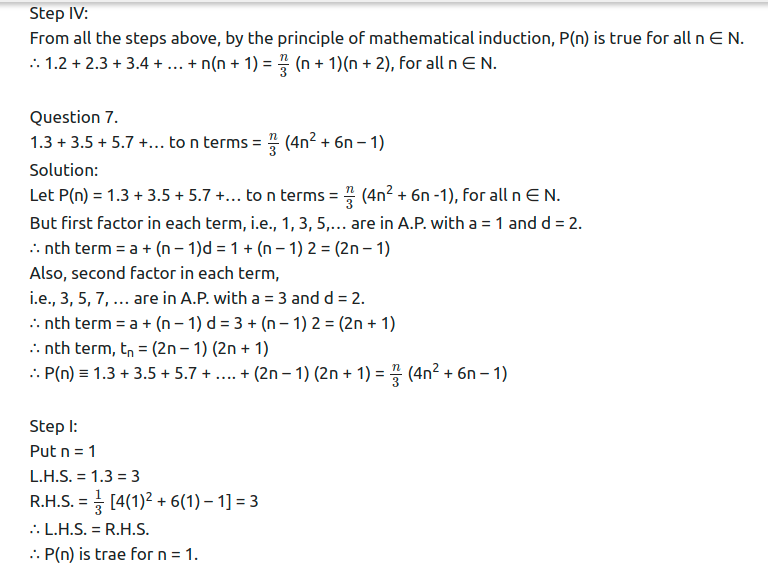
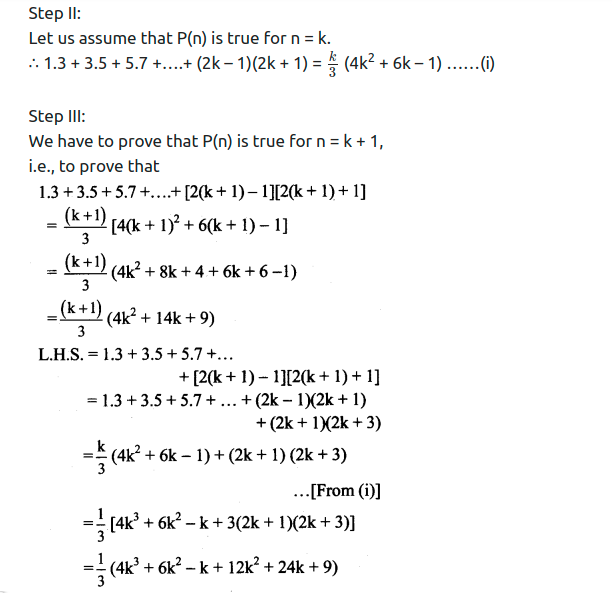

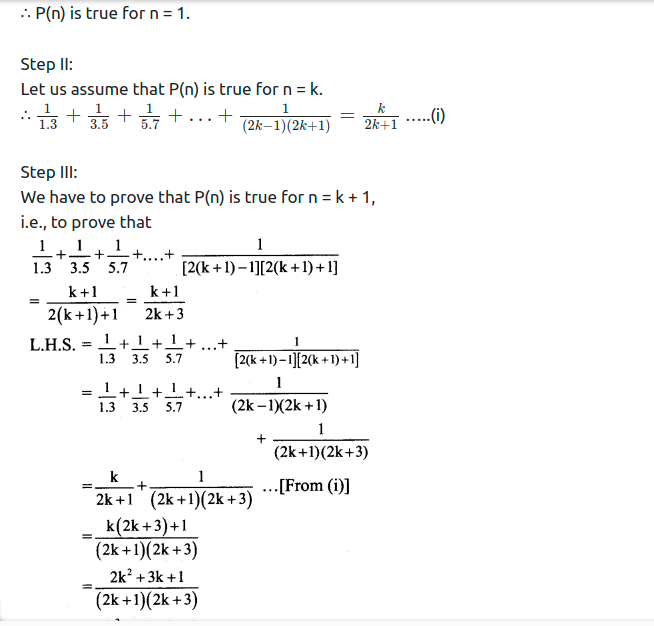
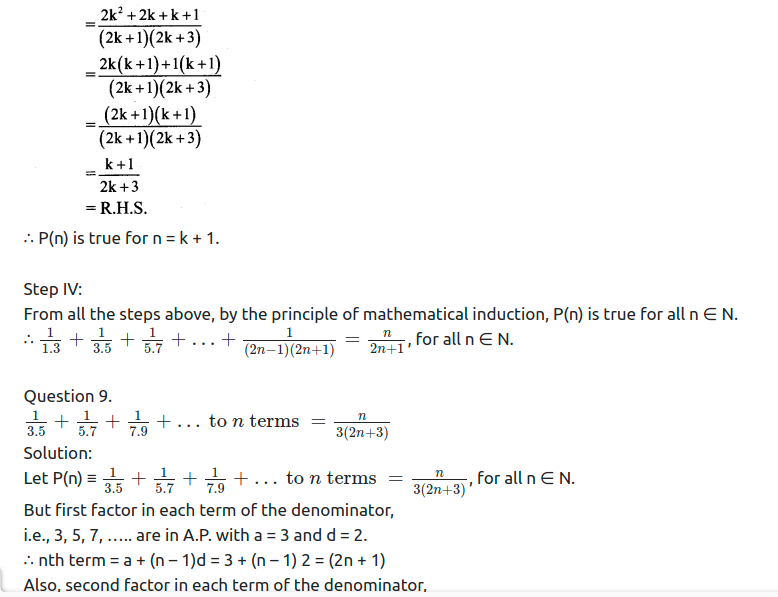
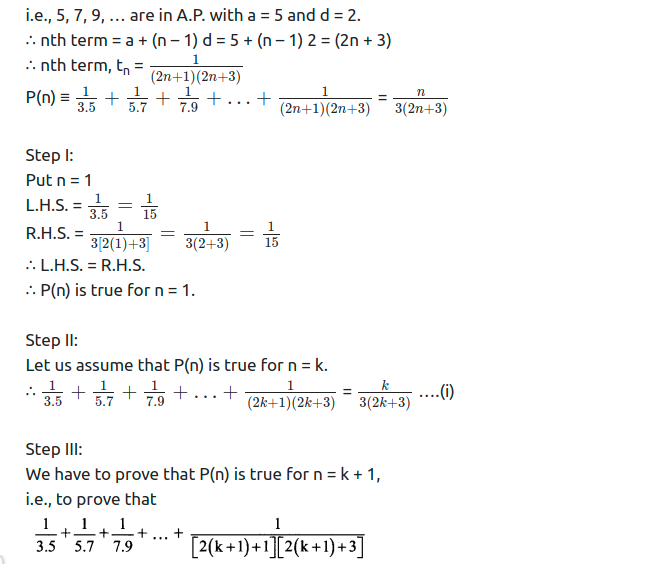
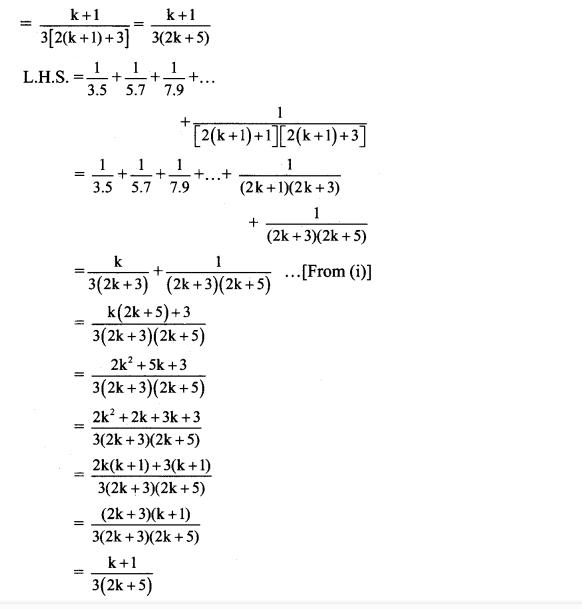
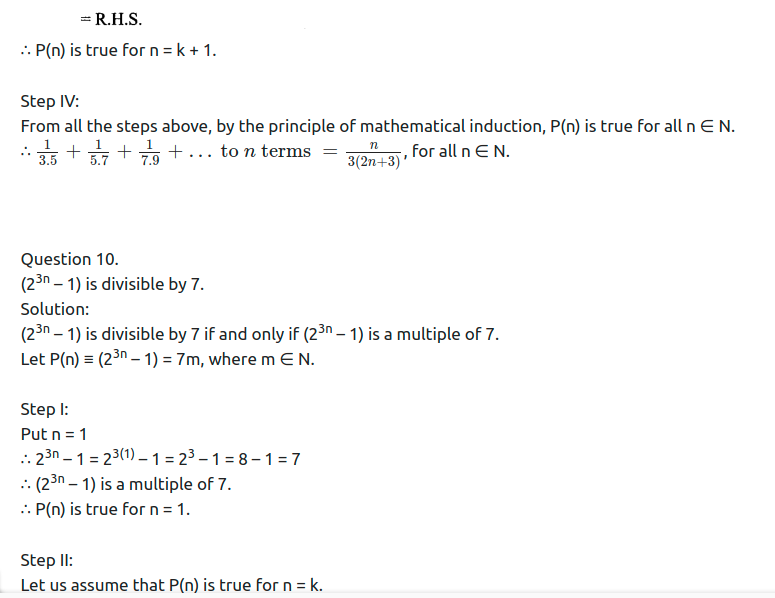
i.e., 23k – 1 is a multiple of 7.
∴ 23k – 1 = 7a, where a ∈ N
∴ 23k = 7a + 1 ……(i)
Step III:
We have to prove that P(n) is true for n = k + 1,
i.e., to prove that
23(k+1) – 1 = 7b, where b ∈ N.
∴ P(k + 1) = 23(k+1) – 1
= 23k+3 – 1
= 23k . (23) – 1
= (7a + 1)8 – 1 …..[From (i)]
= 56a + 8 – 1
= 56a + 7
= 7(8a + 1)
7b, where b = (8a + 1) ∈ N
∴ P(n) is true for n = k + 1.
Step IV:
From all the steps above, by the principle of mathematical induction, P(n) is true for all n ∈ N.
∴ (24n – 1) is divisible by 7, for all n ∈ N.
Question 11.
(24n – 1) is divisible by 15.
Solution:
(24n – 1) is divisible by 15 if and only if (24n – 1) is a multiple of 15.
Let P(n) ≡ (24n – 1) = 15m, where m ∈ N.
Step I:
Put n = 1
∴ 24(1) – 1 = 16 – 1 = 15
∴ (24n – 1) is a multiple of 15.
∴ P(n) is true for n = 1.
Step II:
Let us assume that P(n) is true for n = k.
∴ 24k – 1 = 15a, where a ∈ N
∴ 24k = 15a + 1 …..(i)
Step III:
We have to prove that P(n) is true for n = k + 1,
i.e., to prove that
∴ 24(k+1) – 1 = 15b, where b ∈ N
∴ P(k + 1) = 24(k+1) – 1 = 24k+4 – 1
= 24k . 24 – 1
= 16 . (24k) – 1
= 16(15a + 1) – 1 …..[From (i)]
= 240a + 16 – 1
= 240a + 15
= 15(16a + 1)
= 15b, where b = (16a + 1) ∈ N
∴ P(n) is true for n = k + 1.
Step IV:
From all the steps above, by the principle of mathematical induction, P(n) is true for all n ∈ N.
∴ (24n – 1) is divisible by 15, for all n ∈ N.
Question 12.
3n – 2n – 1 is divisible by 4.
Solution:
(3n – 2n – 1) is divisible by 4 if and only if (3n – 2n – 1) is a multiple of 4.
Let P(n) ≡ (3n – 2n – 1) = 4m, where m ∈ N.
Step I:
Put n = 1
∴ (3n – 2n – 1) = 3(1) – 2(1) – 1 = 0 = 4(0)
∴ (3n – 2n – 1) is a multiple of 4.
∴ P(n) is tme for n = 1.
Step II:
Let us assume that P(n) is true for n = k.
∴ 3k – 2k – 1 = 4a, where a ∈ N
∴ 3k = 4a + 2k + 1 ….(i)
Step III:
We have to prove that P(n) is tme for n = k + 1,
i.e., to prove that
3(k+1) – 2(k + 1) – 1 = 4b, where b ∈ N
P(k + 1) = 3k+1 – 2(k + 1) – 1
= 3k . 3 – 2k – 2 – 1
= (4a + 2k + 1) . 3 – 2k – 3 …….[From (i)]
= 12a + 6k + 3 – 2k – 3
= 12a + 4k
= 4(3a + k)
= 4b, where b = (3a + k) ∈ N
∴ P(n) is tme for n = k + 1.
Step IV:
From all the steps above, by the principle of mathematical induction, P(n) is tme for all n ∈ N.
∴ 3n – 2n – 1 is divisible by 4, for all n ∈ N.
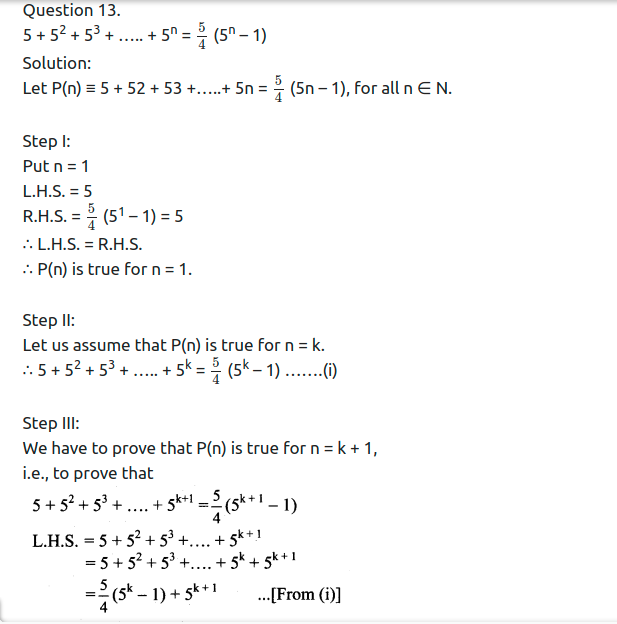
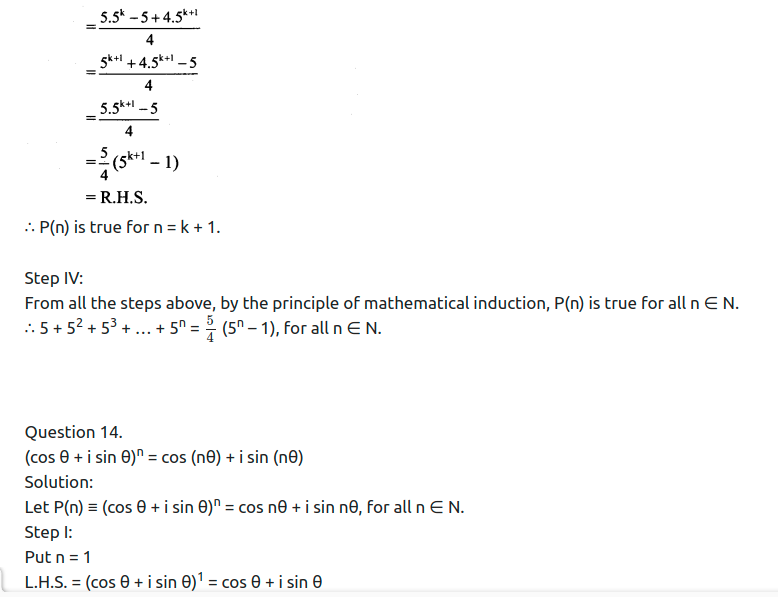
R.H.S. = cos[(1)θ] + i sin[(1)θ] = cos θ + i sin θ
∴ L.H.S. = R.H.S.
∴ P(n) is true for n = 1.
Step II:
Let us assume that P(n) is true for n = k.
∴ (cos θ + i sin θ)k = cos kθ + i sin kθ …….(i)
Step III:
We have to prove that P(n) is true for n = k + 1,
i.e., to prove that
(cos θ + i sin θ)k+1 = cos (k + 1)θ + i sin (k + 1)θ
L.H.S. = (cos θ + i sin θ)k+1
= (cos θ + i sin θ)k . (cos θ + i sin θ)
= (cos kθ + i sin kθ) . (cos θ + i sin θ) ……[From (i)]
= cos kθ cos θ + i sin θ cos kθ + i sin kθ cosθ – sin kθ sin θ ……[∵ i2 = -1]
= (cos kθ cos θ – sin k θ sin θ) + i(sin kθ cos θ + cos kθ sin θ)
= cos(kθ + θ) + i sin(kθ + θ)
= cos(k + 1) θ + i sin (k + 1) θ
= R.H.S.
∴ P(n) is true for n = k + 1.
Step IV:
From all the steps above, by the principle of mathematical induction, P(n) is true for all n ∈ N.
∴ (cos θ + i sin θ)n = cos (nθ) + i sin (nθ), for all n ∈ N.
Question 15.
Given that tn+1 = 5 tn+4, t1 = 4, prove by method of induction that tn = 5n – 1.
Solution:
Let the statement P(n) has L.H.S. a recurrence relation tn+1 = 5 tn+4, t1 = 4 and R.H.S. a general statement tn = 5n – 1.
Step I:
Put n = 1
L.H.S. = 4
R.H.S. = 51 – 1 = 4
∴ L.H.S. = R.H.S.
∴ P(n) is true for n = 1.
Put n = 2
L.H.S. = t2 = 5t1 + 4 = 24
R.H.S. = t2 = 52 – 1 = 24
∴ L.H.S. = R.H.S.
∴ P(n) is true for n = 2.
Step II:
Let us assume that P(n) is true for n = k.
∴ tk+1 = 5 tk+4 and tk = 5k – 1
Step III:
We have to prove that P(n) is true for n = k + 1,
i.e., to prove that tk+1 = 5k+1 – 1
Since tk+1 = 5 tk+4 and tk = 5k – 1 …..[From Step II]
tk+1 = 5 (5k – 1) + 4 = 5k+1 – 1
∴ P(n) is true for n = k + 1.
Step IV:
From all the steps above, by the principle of mathematical induction, P(n) is true for all n ∈ N.
∴ tn = 5n – 1, for all n ∈ N.
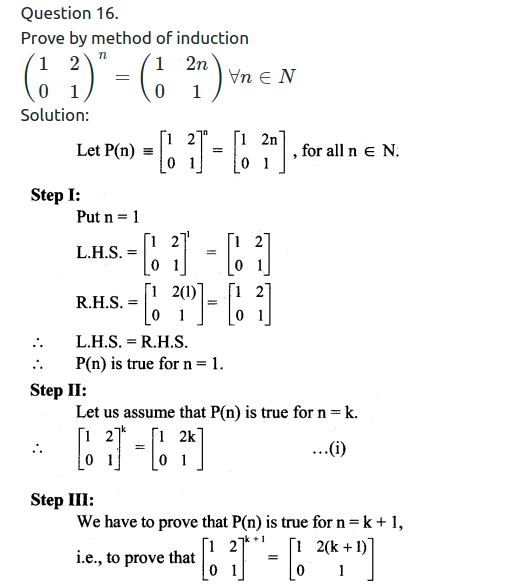
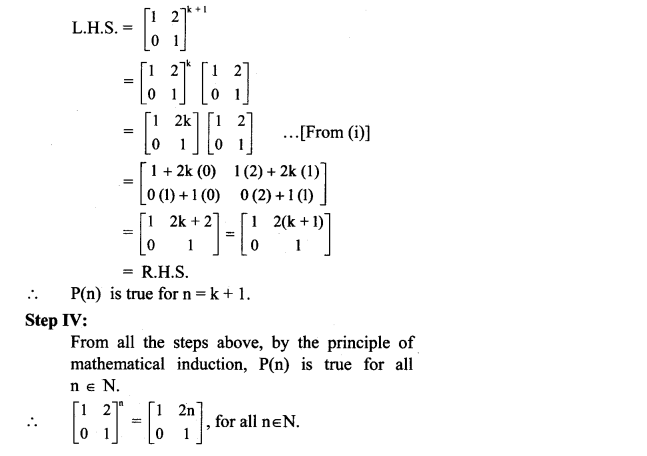
Ex 4.2
Question 1.
Expand:
(i) (√3 + √2)4
Solution:
Here, a = √3, b = √2 and n = 4.
Using binomial theorem,
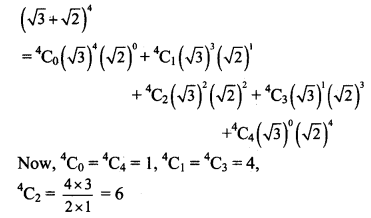
∴ (√3 + √2)4 = 1(9) (1) + 4(3√3) (√2) + 6(3)(2) + 4(√3) (2√2) + 1(1)(4)
= 9 + 12√6 + 36 + 8√6 + 4
= 49 + 20√6
(ii) (√5 – √2)5
Solution:
Here, a = √5, b = √2 and n = 5.
Using binomial theorem,

Question 2.
Expand:
(i) (2x2 + 3)4
Solution:
Here, a = 2x2, b = 3 and n = 4.
Using binomial theorem,
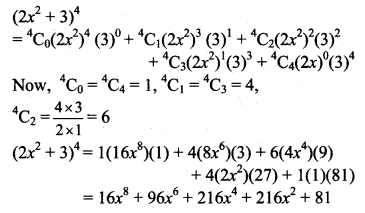
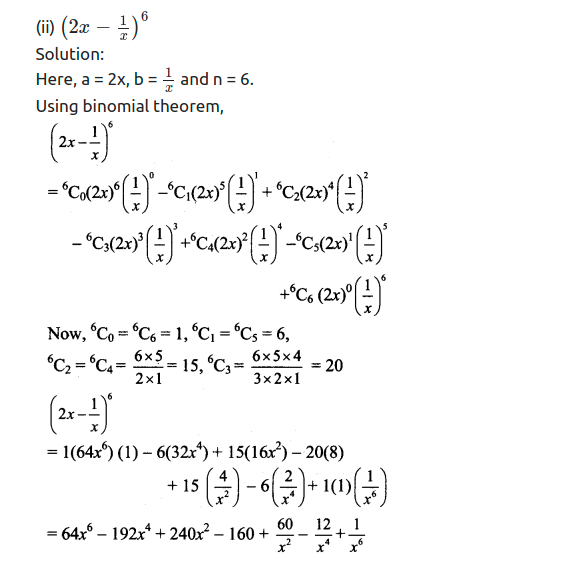
Question 3.
Find the value of
(i) (√3 + 1)4 – (√3 – 1)4
Solution:
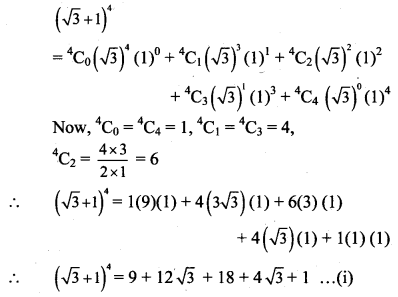
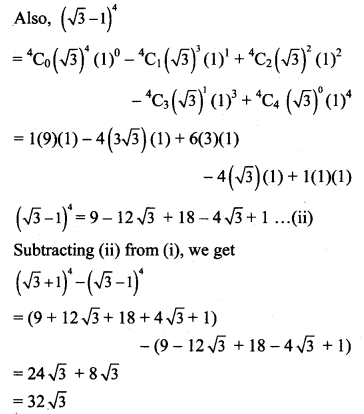
(ii) (2 + √5)5 + (2 – √5)5
Solution:

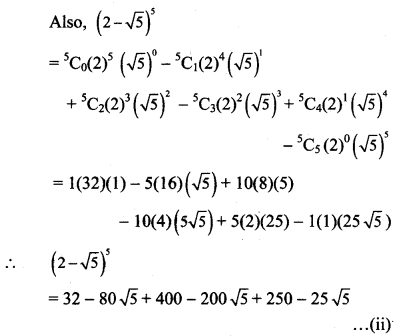
Adding (i) and (ii), we get
∴ (2 + √5 )5 + (2 – √5)5 = (32 + 80√5 + 400 + 200√5 + 250 + 25√5) + (32 – 80√5 + 400 – 200√5+ 250 – 25√5 )
= 64 + 800 + 500
= 1364
Question 4.
Prove that:
(i) (√3 + √2)6 + (√3 – √2)6 = 970
Solution:
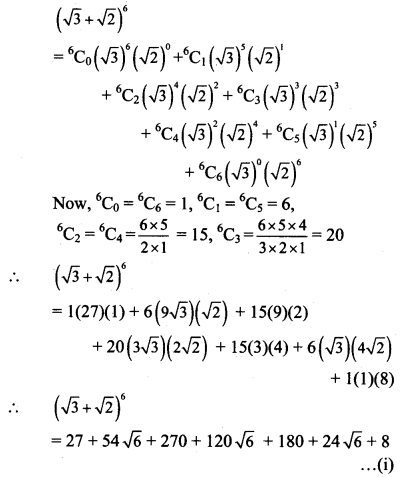
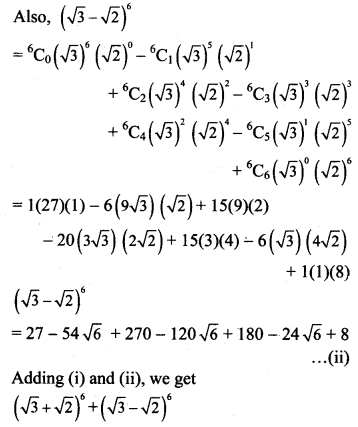
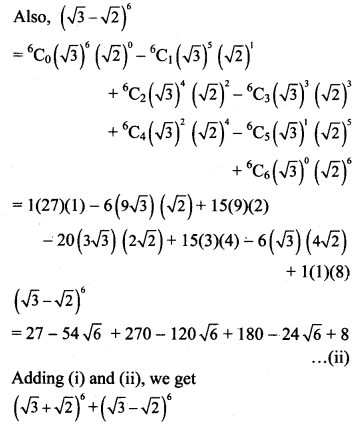
(ii) (√5 + 1)5 – (√5 – 1)5 = 352
Solution:
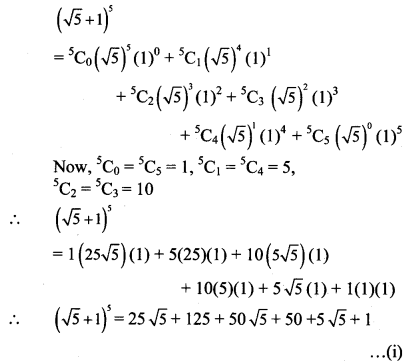
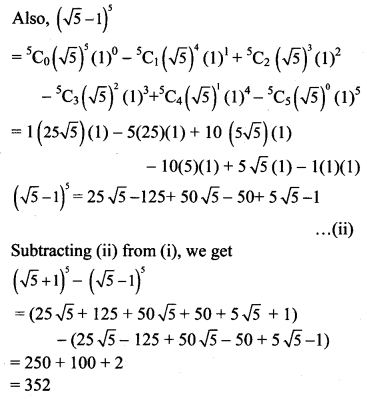
Question 5.
Using binomial theorem, find the value of
(i) (102)4
Solution:

(ii) (1.1)5
Solution:

Question 6.
Using binomial theorem, find the value of
(i) (9.9)3
Solution:
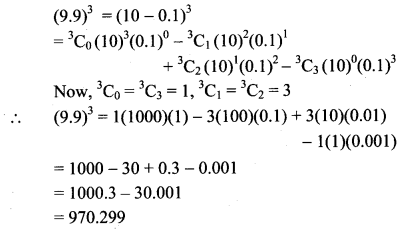
(ii) (0.9)4
Solution:
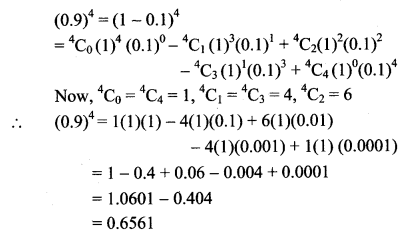
Question 7.
Without expanding, find the value of
(i) (x + 1)4 – 4(x + 1)3 (x – 1) + 6(x + 1)2 (x – 1)2 – 4(x + 1) (x – 1)3 + (x – 1)4
Solution:
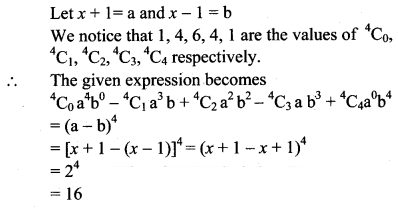
(ii) (2x – 1)4 + 4(2x – 1)3 (3 – 2x) + 6(2x – 1)2 (3 – 2x)2 + 4(2x – 1)1 (3 – 2x)3 + (3 – 2x)4
Solution:
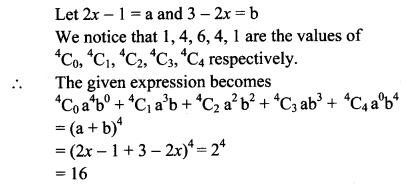
Question 8.
Find the value of (1.02)6, correct upto four places of decimals.
Solution:
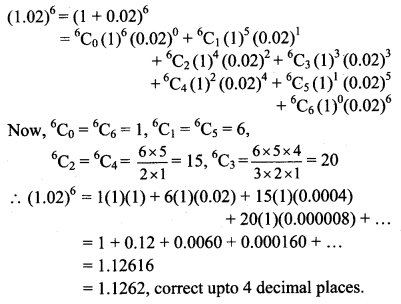
Question 9.
Find the value of (1.01)5, correct upto three places of decimals.
Solution:
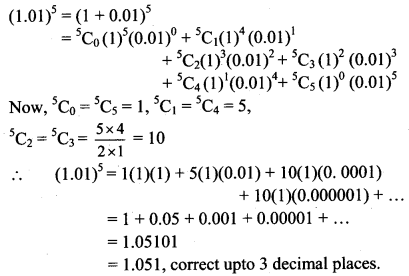
Question 10.
Find the value of (0.9)6, correct upto four places of decimals.
Solution:
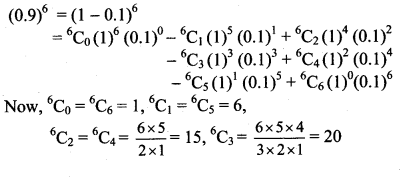
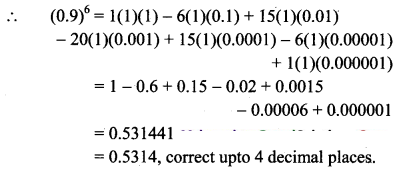
Ex 4.3
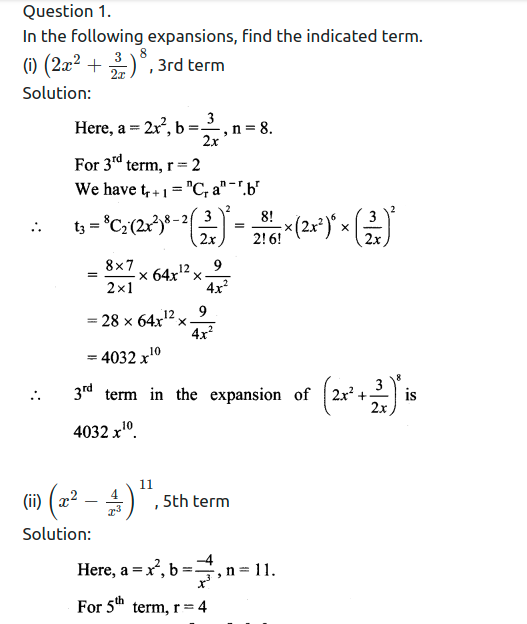
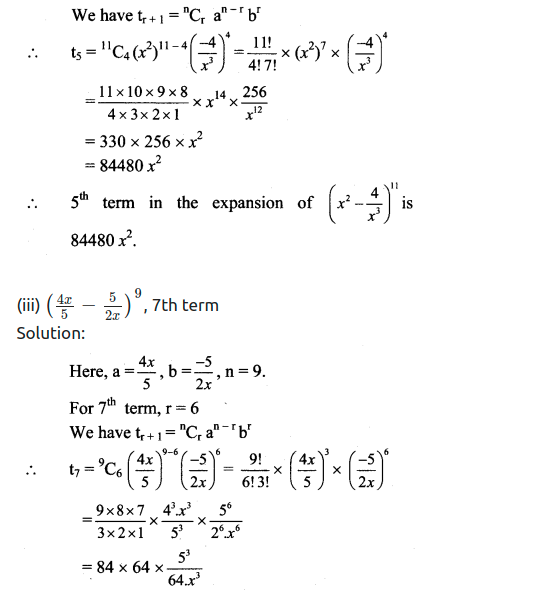
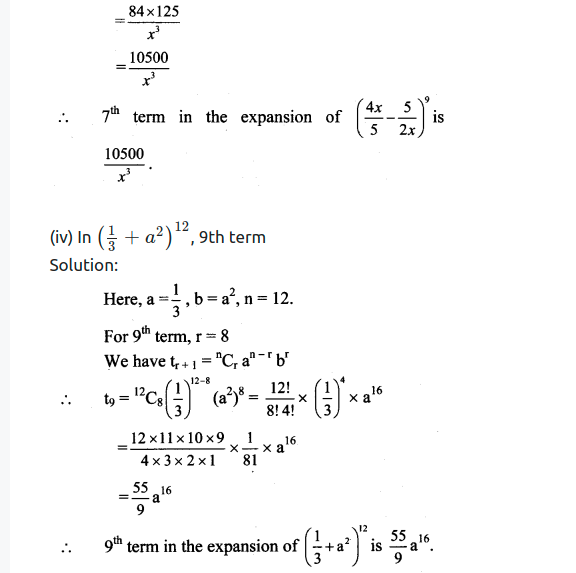
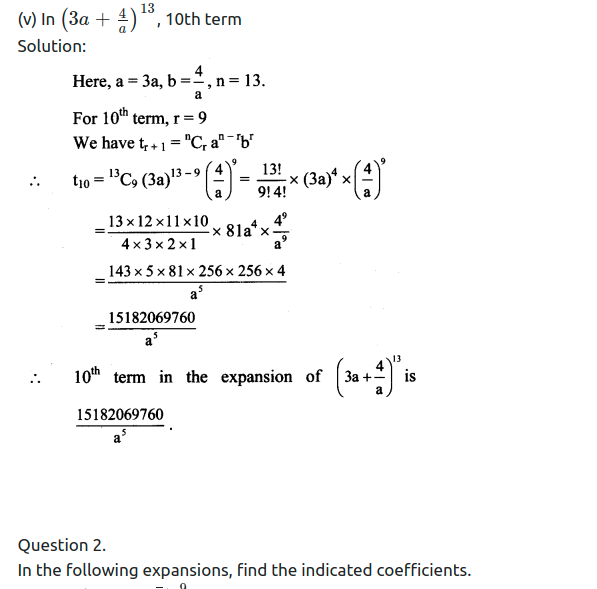

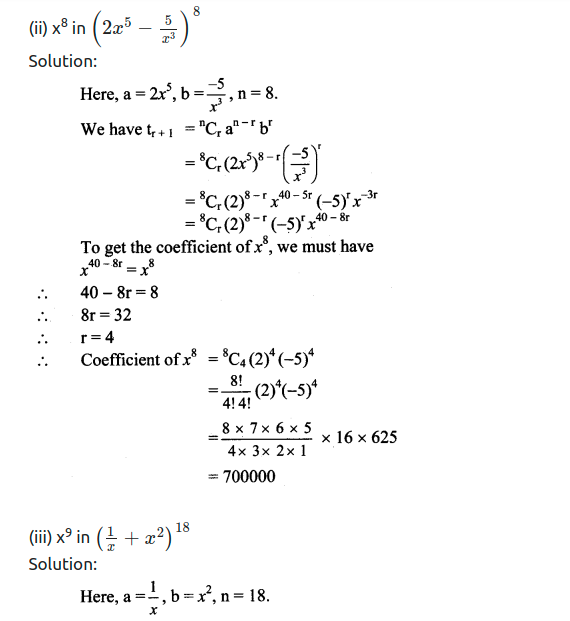

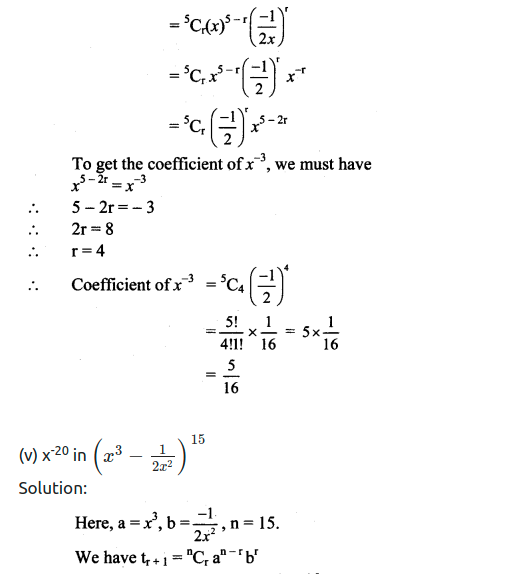
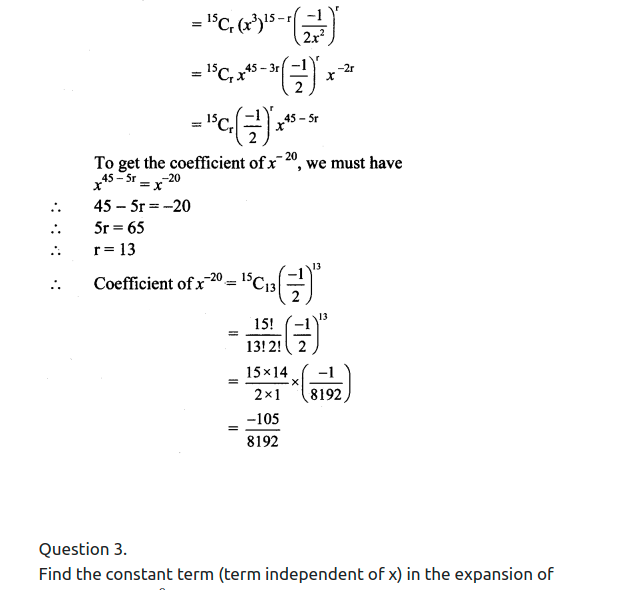
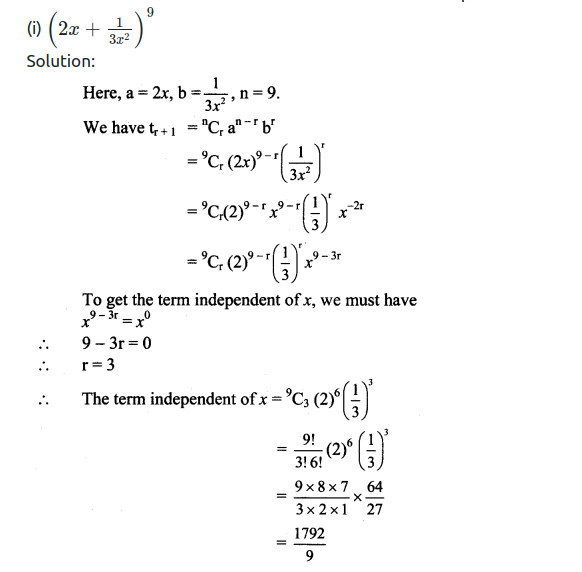
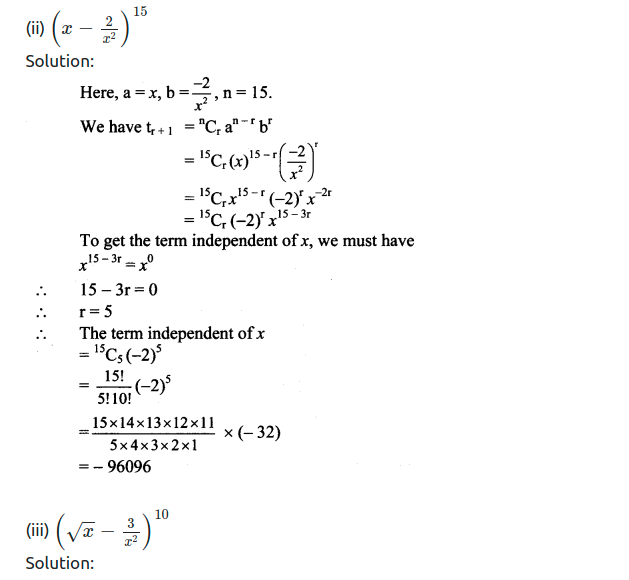
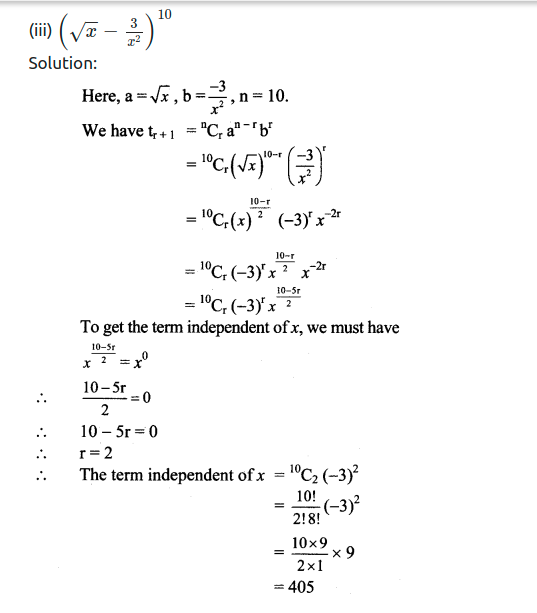
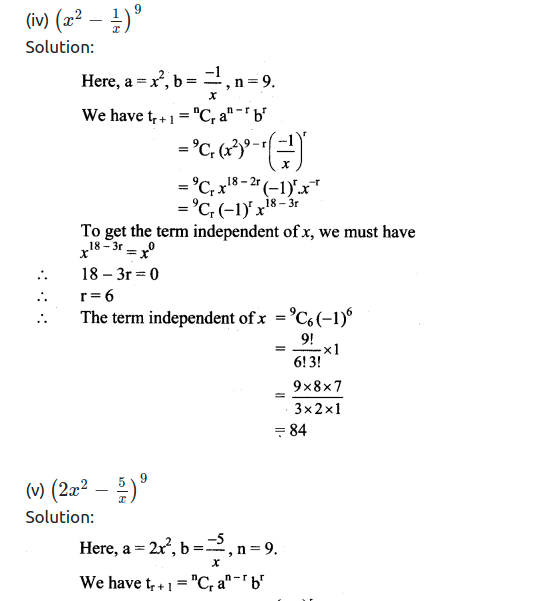
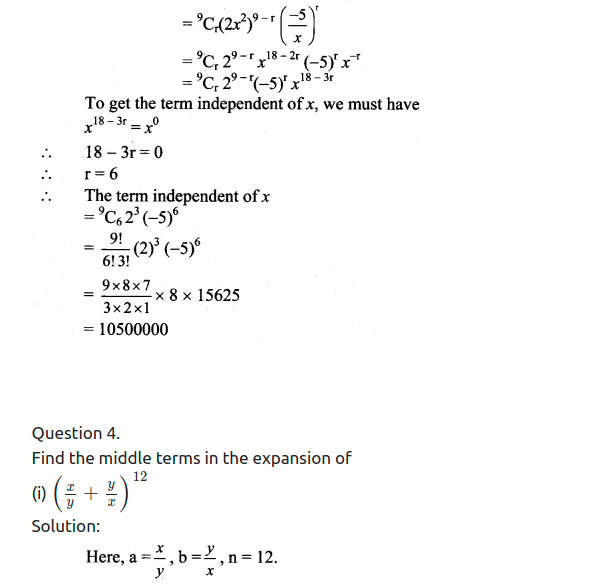
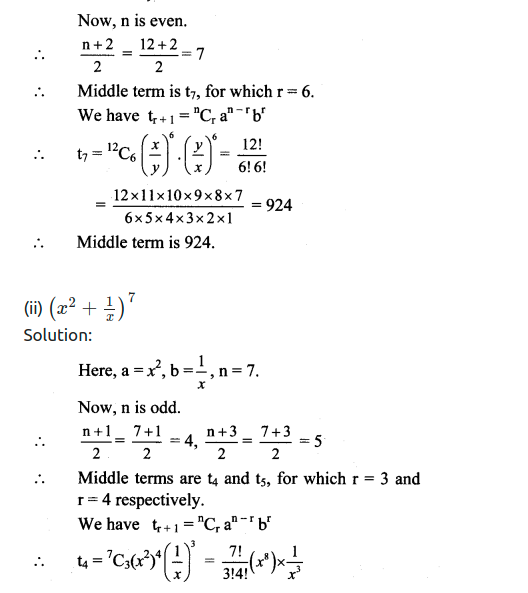
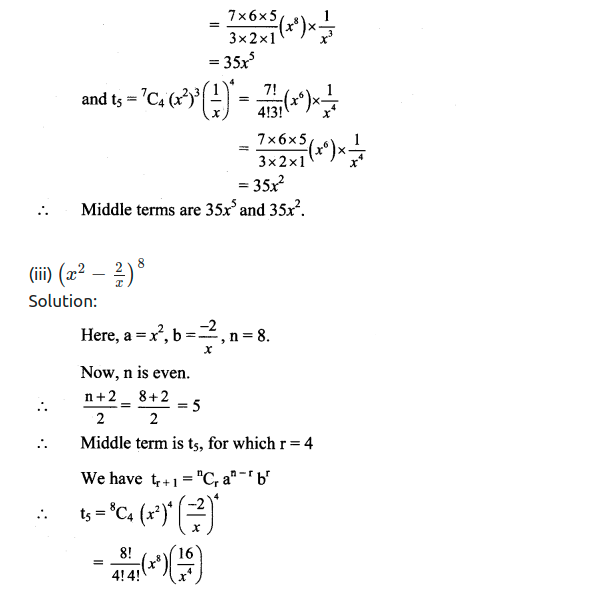


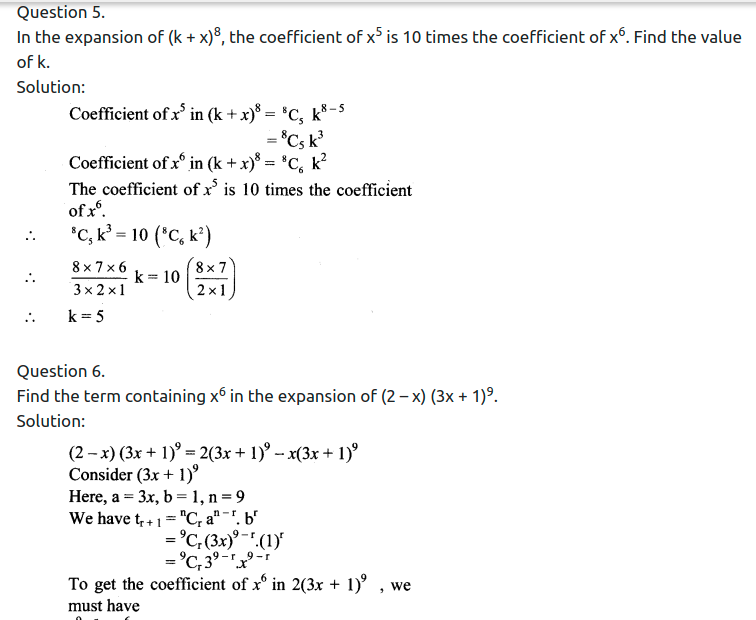
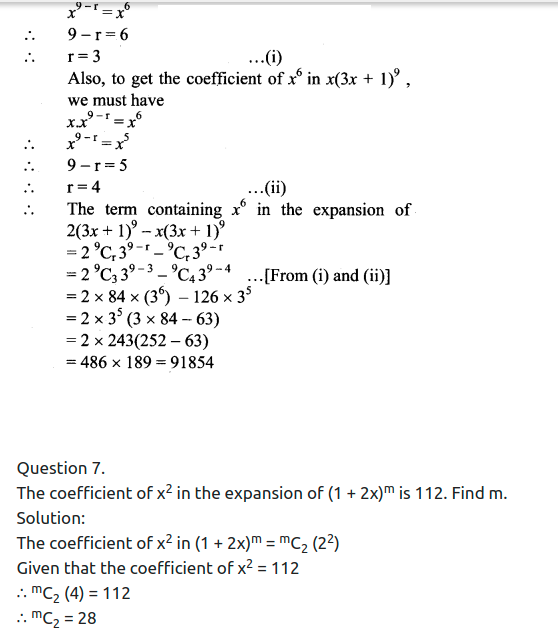
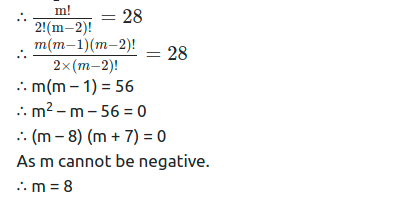
Ex 4.4
Question 1.
State, by writing the first four terms, the expansion of the following, where |x| < 1.
(i) (1 + x)-4
Solution:
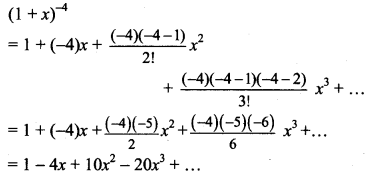
(ii) (1 – x)1/3
Solution:
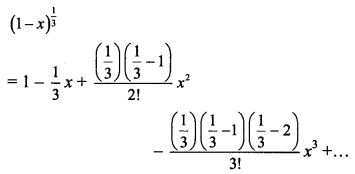
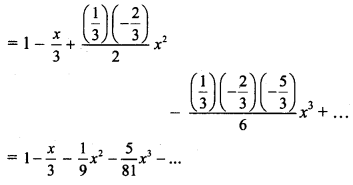
(iii) (1 – x2)-3
Solution:
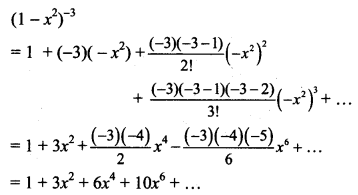
(iv) (1 + x)-1/5
Solution:

(v) (1 + x2)-1
Solution:
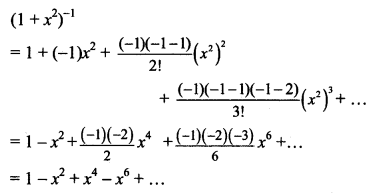
Question 2.
State by writing first four terms, the expansion of the following, where |b| < |a|.
(i) (a – b)-3
Solution:
(a – b)-3 = [a(1−ba)]−3
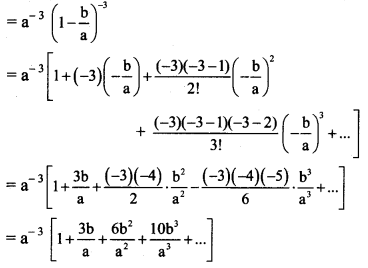
(ii) (a + b)-4
Solution:
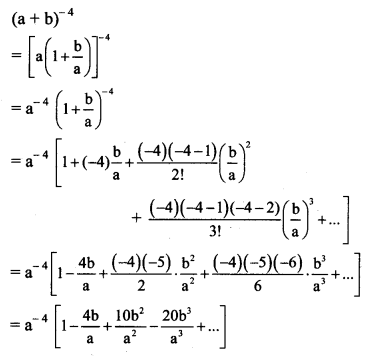
(iii) (a + b)1/4
Solution:
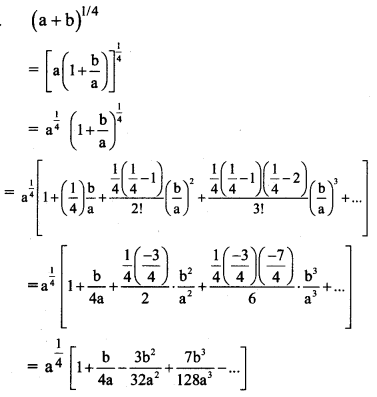
(iv) (a – b)-1/4
Solution:
(a – b)-1/4 = [a(1−ba)]−14
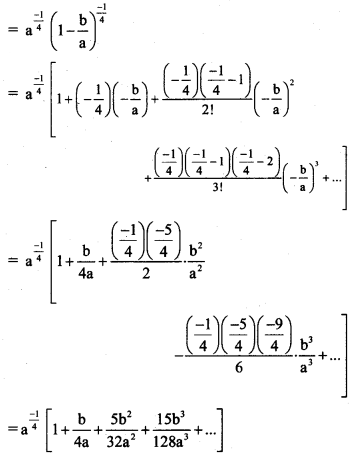
(v) (a + b)-1/3
Solution:
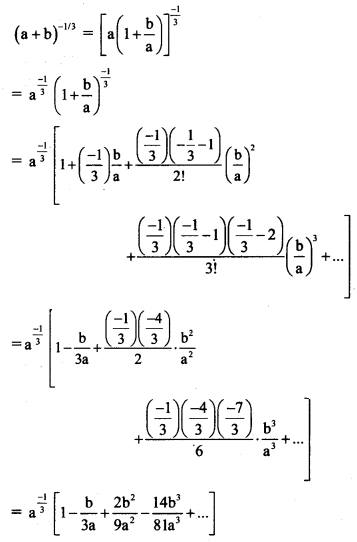
Question 3.
Simplify the first three terms in the expansion of the following:
(i) (1 + 2x)-4
Solution:
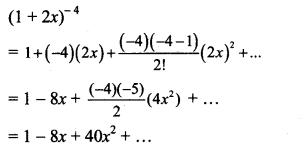
(ii) (1 + 3x)-1/2
Solution:
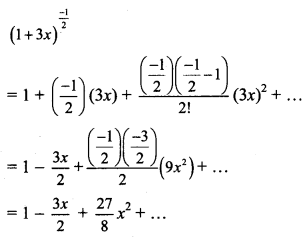
(iii) (2 – 3x)1/3
Solution:
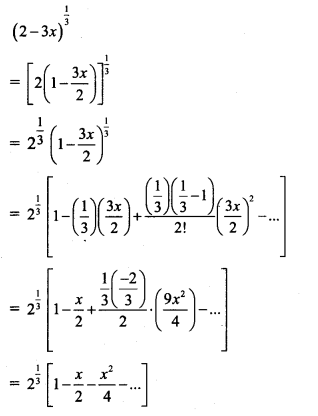
(iv) (5 + 4x)-1/2
Solution:
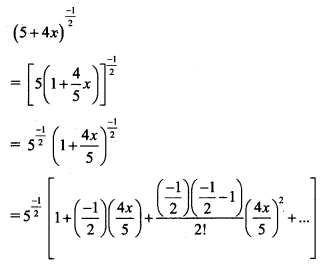

(v) (5 – 3x)-1/3
Solution:

Question 4.
Use the binomial theorem to evaluate the following upto four places of decimals.
(i) √99
Solution:

= 10 [1 – 0.005 – 0.0000125 – ……]
= 10(0.9949875)
= 9.94987 5
= 9.9499
(ii) 126−−−√3
Solution:
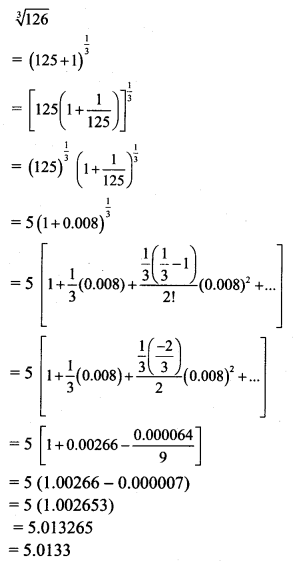
(iii) 16.08−−−−√4
Solution:

(iv) (1.02)-5
Solution:
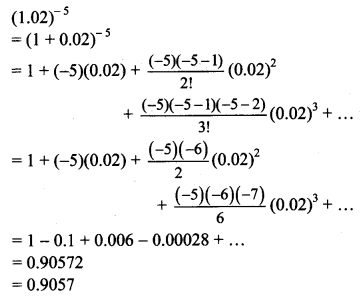
(v) (0.98)-3
Solution:
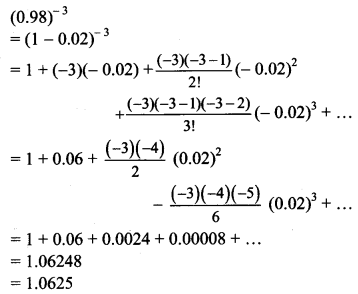
Ex 4.5
Question 1.
Show that C0 + C1 + C2 + ….. + C8 = 256
Solution:
Since C0 + C1 + C2 + C3 + ….. + Cn = 2n
Putting n = 8, we get
C0 + C1 + C2 + ….. + C8 = 28
∴ C0 + C1 + C2 + ….. + C8 = 256
Question 2.
Show that C0 + C1 + C2 + …… + C9 = 512
Solution:
Since C0 + C1 + C2 + C3 + ….. + Cn = 2n
Putting n = 9, we get
C0 + C1 + C2 + ….. + C9 = 29
∴ C0 + C1 + C2 + …… + C9 = 512
Question 3.
Show that C1 + C2 + C3 + ….. + C7 = 127
Solution:
Since C0 + C1 + C2 + C3 + ….. + Cn = 2n
Putting n = 7, we get
C0 + C1 + C2 + ….. + C7 = 27
∴ C0 + C1 + C2 +….. + C7 = 128
But, C0 = 1
∴ 1 + C1 + C2 + ….. + C7 = 128
∴ C1 + C2 + ….. + C7 = 128 – 1 = 127
Question 4.
Show that C1 + C2 + C3 + ….. + C6 = 63
Solution:
Since C0 + C1 + C2 + C3 + ….. + Cn = 2n
Putting n = 6, we get
C0 + C1 + C2 + ….. + C6 = 26
∴ C0 + C1 + C2 + …… + C6 = 64
But, C0 = 1
∴ 1 + C1 + C2 + ….. + C6 = 64
∴ C1 + C2 + ….. + C6 = 64 – 1 = 63
Question 5.
Show that C0 + C2 + C4 + C6 + C8 = C1 + C3 + C5 + C7 = 128
Solution:
Since C0 + C1 + C2 + C3 + …… + Cn = 2n
Putting n = 8, we get
C0 + C1 + C2 + C3 + …… + C8 = 28
But, sum of even coefficients = sum of odd coefficients
∴ C0 + C2 + C4 + C6 + C8 = C1 + C3 + C5 + C7
Let C0 + C2 + C4 + C6 + C8 = C1 + C3 + C5 + C7 = k
Now, C0 + C1 + C2 + C3 + C4 + C5 + C6 + C7 + C8 = 256
∴ (C0 + C2 + C4 + C6 + C8) + (C1 + C3 + C5 + C7) = 256
∴ k + k = 256
∴ 2k = 256
∴ k = 128
∴ C0 + C2 + C4 + C6 + C8 = C1 + C3 + C5 + C7 = 128
Question 6.
Show that C1 + C2 + C3 + ….. + Cn = 2n – 1
Solution:
Since C0 + C1 + C2 + C3 + ….. + Cn = 2n
But, C0 = 1
∴ 1 + C1 + C2 + C3 + …… + Cn = 2n
∴ C1 + C2 + C3 + ….. + Cn = 2n – 1
Question 7.
Show that C0 + 2C1 + 3C2 + 4C3 + ….. + (n + 1)Cn = (n + 2) 2n-1
Solution:
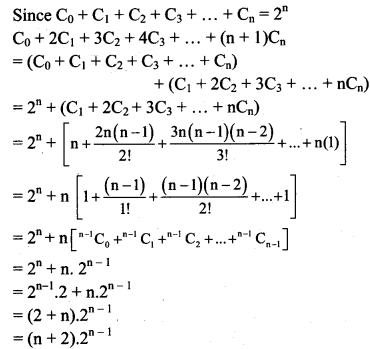
Download PDF
Maharashtra Board Solutions Class 11-Arts & Science Maths (Part 2): Chapter 4- Methods of Induction and Binomial Theorem
Chapterwise Maharashtra Board Solutions Class 11 Arts & Science Maths (Part 2) :
- Chapter 1- Complex Numbers
- Chapter 2- Sequences and Series
- Chapter 3- Permutations and Combination
- Chapter 4- Methods of Induction and Binomial Theorem
- Chapter 5- Sets and Relations
- Chapter 6- Functions
- Chapter 7- Limits
- Chapter 8- Continuity
- Chapter 9- Differentiation
FAQs
You can download the Maharashtra State Board Books from the eBalbharti official website, i.e. cart.ebalbharati.in or from this article.
Students can get the Maharashtra Books for primary, secondary, and senior secondary classes from here. You can view or download the Maharashtra State Board Books from this page or from the official website for free of cost. Students can follow the detailed steps below to visit the official website and download the e-books for all subjects or a specific subject in different mediums.
Step 1: Visit the official website ebalbharati.in
Step 2: On the top of the screen, select “Download PDF textbooks”
Step 3: From the “Classes” section, select your class.
Step 4: From “Medium”, select the medium suitable to you.
Step 5: All Maharashtra board books for your class will now be displayed on the right side.
Step 6: Click on the “Download” option to download the PDF book.
As of now, the MSCERT and Balbharti are responsible for the syllabus and textbooks of Classes 1 to 8, while Classes 9 and 10 are under the Maharashtra State Board of Secondary and Higher Secondary Education (MSBSHSE).
The Maharashtra State Board of Secondary & Higher Secondary Education, conducts the HSC and SSC Examinations in the state of Maharashtra through its nine Divisional Boards located at Pune, Mumbai, Aurangabad, Nasik, Kolhapur, Amravati, Latur, Nagpur and Ratnagiri.
About Maharashtra State Board (MSBSHSE)
The Maharashtra State Board of Secondary and Higher Secondary Education or MSBSHSE (Marathi: महाराष्ट्र राज्य माध्यमिक आणि उच्च माध्यमिक शिक्षण मंडळ), is an autonomous and statutory body established in 1965. The board was amended in the year 1977 under the provisions of the Maharashtra Act No. 41 of 1965.
The Maharashtra State Board of Secondary & Higher Secondary Education (MSBSHSE), Pune is an independent body of the Maharashtra Government. There are more than 1.4 million students that appear in the examination every year. The Maha State Board conducts the board examination twice a year. This board conducts the examination for SSC and HSC.
The Maharashtra government established the Maharashtra State Bureau of Textbook Production and Curriculum Research, also commonly referred to as Ebalbharati, in 1967 to take up the responsibility of providing quality textbooks to students from all classes studying under the Maharashtra State Board. MSBHSE prepares and updates the curriculum to provide holistic development for students. It is designed to tackle the difficulty in understanding the concepts with simple language with simple illustrations. Every year around 10 lakh students are enrolled in schools that are affiliated with the Maharashtra State Board.
Read More
IndCareer Board Book Solutions App
IndCareer Board Book App provides complete study materials for students from classes 1 to 12 of Board. The App contains complete solutions of NCERT books, notes, and other important materials for students. Download the IndCareer Board Book Solutions now.

